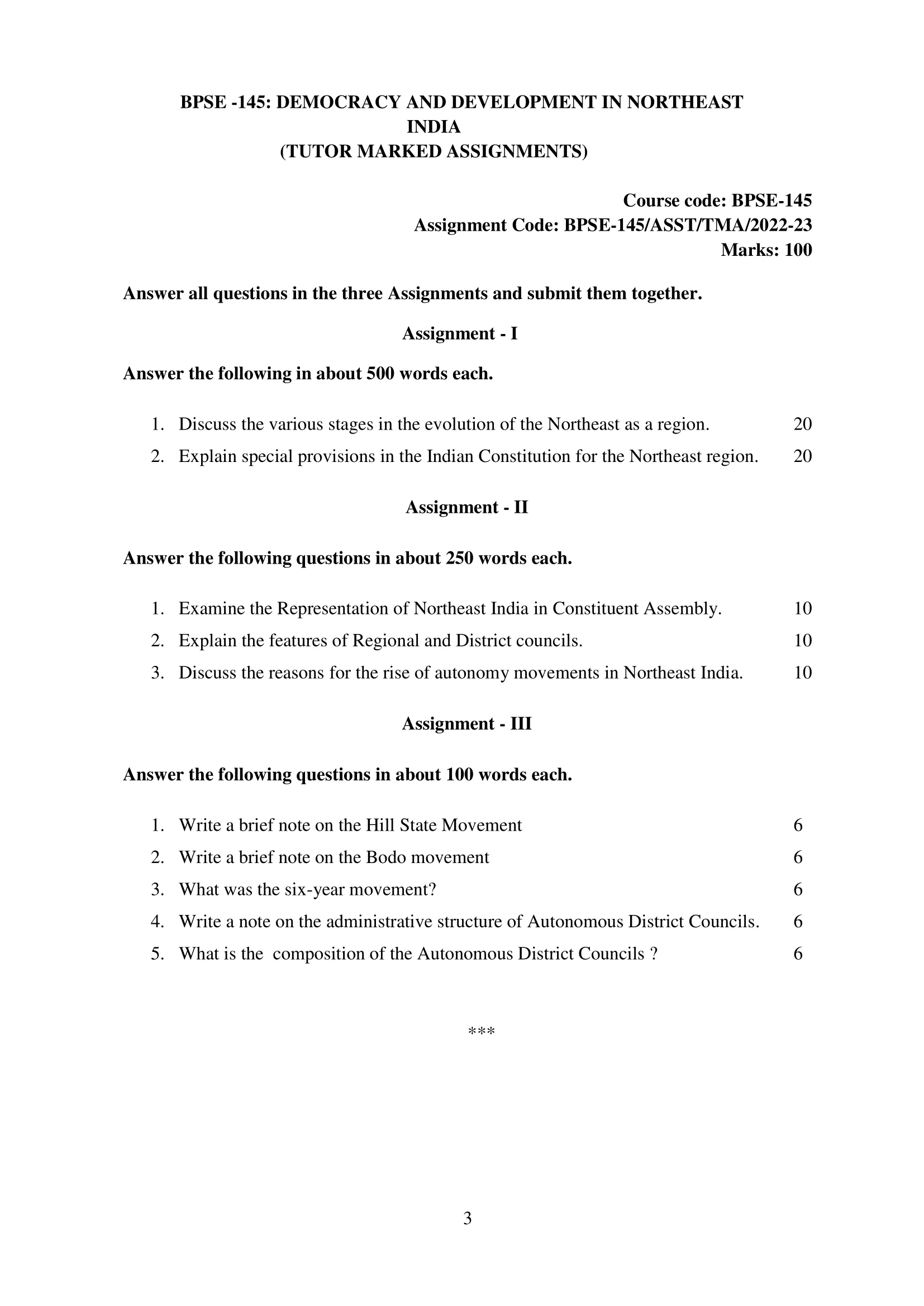Contents
- 1 Assignment – I
- 2 Answer the following in about 500 words each.
- 3 1. Discuss the various stages in the evolution of the Northeast as a region.
- 4 2. Explain special provisions in the Indian Constitution for the Northeast region.
- 5 Assignment – II
- 6 Answer the following questions in about 250 words each.
- 7 1. Examine the Representation of Northeast India in Constituent Assembly.
- 8 2. Explain the features of Regional and District councils.
- 9 3. Discuss the reasons for the rise of autonomy movements in Northeast India.
- 10 Assignment – III
- 11 Answer the following questions in about 100 words each.
- 12 1. Write a brief note on the Hill State Movement.
- 13 2. Write a brief note on the Bodo movement.
- 14 3. What was the six-year movement?
- 15 4. Write a note on the administrative structure of Autonomous District Councils.
- 16 5. What is the composition of the Autonomous District Councils ?

| Title | BPSE-145: IGNOU BAG Solved Assignment 2022-2023 |
| University | IGNOU |
| Degree | Bachelor Degree Programme |
| Course Code | BPSE-145 |
| Course Name | DEMOCRACY AND DEVELOPMENT IN NORTHEAST INDIA |
| Programme Name | Bachelor of Arts (General) |
| Programme Code | BAG |
| Total Marks | 100 |
| Year | 2022-2023 |
| Language | English |
| Assignment Code | BPSE-145/ASST/TMA/2022-23 |
| Last Date for Submission of Assignment: | For June Examination: 31st April For December Examination: 30th September |

Assignment – I
Answer the following in about 500 words each.
1. Discuss the various stages in the evolution of the Northeast as a region.
Ans: The Northeast region of the United States has undergone a series of transformations since its settlement in the early 1600s. Here is an overview of the major stages in its evolution:
- Early settlement and colonial expansion (1600s-1775) – The Northeast was the first region in what is now the United States to be settled by Europeans. The Dutch and the English were among the first to establish colonies, which soon expanded into the hinterlands and beyond. The region was home to the original 13 British colonies, and played a key role in the American Revolution.
- Industrialization (1775-1860) – The Northeast underwent a rapid transformation during the Industrial Revolution. The region was home to the first American factories, as well as a growing number of cities and ports. The economy became increasingly centered around manufacturing, trade, and transportation.
- The Civil War and Reconstruction (1860-1877) – The Northeast played a major role in the American Civil War, providing much of the manpower and resources for the Union Army. After the war, the region became a center for the growing abolitionist movement, and was instrumental in the passage of the 13th, 14th, and 15th amendments to the Constitution.
- The Gilded Age (1877-1900) – The Gilded Age saw the Northeast continue to thrive as an economic power, with cities like New York and Boston becoming major centers of finance and commerce. At the same time, the region was home to a growing number of immigrants, many of whom worked in the factories and mills.
- The Progressive Era (1900-1917) – The Progressive Era saw the Northeast become a leader in the national reform movements of the time. Reformers pushed for greater government regulation of business, improved working conditions, and better access to education and healthcare.
- World War I and the Interwar Years (1917-1939) – The Northeast played a key role in the American effort in World War I, supplying troops, materiel, and financial support. After the war, the region continued to grow and prosper, becoming a major center of manufacturing and trade.
- World War II and the Post-War Years (1939-1960) – The Northeast played a critical role in the American effort in World War II, providing much of the military and industrial muscle needed to defeat the Axis powers. After the war, the region continued to thrive, and became a leader in the emerging technological industries of the time.
- The Civil Rights Movement and the 1960s (1960-1975) – The Northeast was at the forefront of the civil rights movement, and was home to some of the most important leaders of the movement, including Martin Luther King Jr. and Malcolm X. The region also saw major social and political changes during the 1960s, as the counterculture and anti-war movements took hold.
- The Late 20th Century (1975-2000) – The Northeast continued to grow and change during the late 20th century, as globalization and the rise of the information economy transformed the region’s economy. Cities like New York and Boston became major centers of finance, technology, and media, and the region continued to attract immigrants from around the world.
- The 21st Century (2000-present) – The Northeast has faced new challenges in the 21st century, including the aftermath of the September 11th attacks, the 2008 financial crisis, and the ongoing impact of globalization. At the same time, the region continues to be a hub of innovation, and is home to some of the world’s leading universities, museums, and cultural institutions.
2. Explain special provisions in the Indian Constitution for the Northeast region.
Ans: The Indian Constitution recognizes the unique cultural, social, and political character of the Northeast region, and provides a number of special provisions to protect and promote the interests of the people of this region. Here is a summary of some of the key provisions in the Constitution:
- Article 371: This article provides special provisions for the northeastern states of Assam, Nagaland, Manipur, and Arunachal Pradesh. These provisions include the right to preserve their distinct cultural identities and the power to regulate land and resource use in the region.
- Inner Line Permit (ILP): The ILP is a document that is required for non-residents of the northeastern states to enter and stay in the region for a limited period of time. This provision is intended to protect the distinct cultural identities of the people of the region and to regulate the influx of outsiders.
- Scheduled Tribes: The Constitution recognizes the unique cultural and social identities of the tribes in the Northeast region, and provides special provisions for their protection and promotion. This includes the recognition of their customary laws and practices, and the protection of their land and resource rights.
- Autonomous District Councils: The Constitution provides for the creation of autonomous district councils in the northeastern states, which are intended to give tribal communities greater control over their own affairs and to preserve their distinct cultural identities.
- Representation in Parliament: The Northeast region is overrepresented in the Indian Parliament, with more seats allocated to the region than its population would otherwise justify. This is intended to ensure that the voices of the people of the region are heard in the national political process.
- Special Economic Zones: The Indian government has established a number of special economic zones in the Northeast region, which are designed to promote economic development and job creation in the region. These zones offer tax incentives and other benefits to investors and businesses, and are intended to help close the gap between the Northeast and other parts of India in terms of economic development.
- Education and Culture: The Constitution provides for the promotion of education and culture in the Northeast region, with special provisions for the preservation of the unique cultural heritage of the region. This includes the promotion of tribal languages and the protection of traditional practices and customs.
- North Eastern Council: The Indian government has established the North Eastern Council, which is intended to coordinate and promote economic and social development in the region. The council is comprised of representatives from the eight northeastern states, and is intended to help address the unique development challenges faced by the region.
- Special Provision for Women: The Constitution provides special provisions for the protection and promotion of the rights of women in the Northeast region, including provisions for the promotion of gender equality and the protection of women’s rights in the workplace.
Assignment – II
Answer the following questions in about 250 words each.
1. Examine the Representation of Northeast India in Constituent Assembly.
Ans: Northeast India refers to the eight states of Arunachal Pradesh, Assam, Manipur, Meghalaya, Mizoram, Nagaland, Tripura, and Sikkim. These states are culturally, linguistically, and geographically distinct from the rest of India. During the time of the Constituent Assembly, which was established to draft the Indian Constitution, Northeast India was represented by several leaders.
Some of the notable leaders from the region who were members of the Constituent Assembly include Gopinath Bardoloi from Assam, TT Krishnamachari from Manipur, and BK Roy from Tripura. These leaders used their platform in the Assembly to represent the voices and interests of their respective states and the region as a whole.
Despite the presence of these leaders, the representation of Northeast India in the Constituent Assembly was limited. The region was still largely underexposed, and its unique cultural, linguistic, and political identities were not fully represented in the Constitution. This was due in part to the limited representation from the region and the dominance of leaders from other parts of India.
2. Explain the features of Regional and District councils.
Ans: Regional and district councils are administrative entities established to manage and oversee the administration of specific regions or districts within a country. These councils play a crucial role in local governance and are responsible for addressing the needs and concerns of their respective regions or districts.
The features of regional and district councils vary depending on the country and political system, but some common features include:
- Elected representatives: Regional and district councils are typically composed of elected representatives who serve as the voice of the people in their respective regions or districts.
- Local autonomy: Regional and district councils have a significant degree of autonomy in managing the affairs of their regions or districts. This includes the ability to make decisions regarding local development projects, the allocation of resources, and the provision of public services.
- Budgetary powers: Regional and district councils typically have the power to generate revenue and control their own budgets, which allows them to prioritize the needs and concerns of their respective regions or districts.
- Responsiveness to local needs: The primary role of regional and district councils is to respond to the needs and concerns of their regions or districts. This includes addressing issues related to infrastructure, health, education, and other public services.
- Representation of diverse interests: Regional and district councils aim to represent the diverse interests of their regions or districts, including ethnic and linguistic groups, as well as minority communities.
3. Discuss the reasons for the rise of autonomy movements in Northeast India.
Ans: Northeast India, which consists of eight states, has a long history of autonomy movements that reflect the unique cultural, linguistic, and political identities of the region. The rise of these movements can be attributed to several reasons, including:
- Cultural and linguistic differences: Northeast India is culturally and linguistically distinct from the rest of India, and the region has a long history of preserving its unique cultural and linguistic heritage. This has led to the rise of movements seeking greater autonomy and recognition for the region’s cultural and linguistic identity.
- Historical marginalization: Northeast India has historically been marginalized and neglected by the central government, and the region has suffered from a lack of investment in infrastructure and public services. This has led to widespread poverty and unemployment, which has fueled demands for greater autonomy and control over the region’s affairs.
- Political exclusion: The region has a history of political exclusion, with limited representation in the central government and a lack of political power. This has led to the rise of movements seeking greater political representation and control over the region’s affairs.
- Economic disparities: The region has also faced economic disparities compared to other parts of India, and this has fueled demands for greater autonomy and control over economic resources and development.
- Natural resources: Northeast India is rich in natural resources, including forests, minerals, and oil, and there have been concerns that these resources are being exploited by outside interests without benefiting the local population. This has led to the rise of movements seeking greater control over these resources and their exploitation.
Assignment – III
Answer the following questions in about 100 words each.
1. Write a brief note on the Hill State Movement.
Ans: The Hill State Movement was a political movement in India that arose in the mid-20th century, in response to growing discontent among the tribal communities of the northeastern states. The movement was centered on the demand for greater autonomy and self-governance for the hill states of the region, which were largely composed of tribal communities. The movement was led by a number of prominent leaders, including P. Shilu Ao, and was characterized by peaceful protests, demonstrations, and other forms of civil disobedience. The movement gained momentum in the 1950s, and ultimately led to the creation of the autonomous district councils in the region, as well as the recognition of the unique cultural and social identities of the tribal communities of the Northeast. The Hill State Movement remains an important part of the political history of India, and continues to be celebrated by the people of the region as a symbol of their struggle for self-determination and autonomy.
2. Write a brief note on the Bodo movement.
Ans: The Bodo Movement was a political and cultural movement that arose among the Bodo tribe in the Indian state of Assam in the late 20th century. The movement was driven by a desire for greater political autonomy, cultural recognition, and preservation of the Bodo language and way of life. The movement was marked by a series of peaceful protests, negotiations, and, in some instances, violent conflicts with the government. The movement gained national attention and support from other tribal groups in the region, leading to the creation of the Bodoland Territorial Council in 2003, which granted the Bodo tribe greater control over their own affairs and ensured the preservation of their cultural heritage. The Bodo Movement remains an important part of the political and cultural history of Assam and the Northeast region, and continues to influence the political discourse and cultural identity of the Bodo tribe and other tribal communities in the region.
3. What was the six-year movement?
Ans: The six-year movement refers to a political and social movement that took place in the Indian state of Assam during the late 1970s and early 1980s. The movement was a response to widespread grievances among the people of Assam, including political marginalization, economic exploitation, and the influx of immigrants from neighboring countries. The movement was led by the All Assam Students’ Union (AASU) and the All Assam Gana Sangram Parishad (AAGSP), and it lasted for six years from 1979 to 1985. The movement’s demands included the identification and deportation of illegal immigrants, constitutional protection for the rights of the indigenous people of Assam, and greater political representation for the state. The movement resulted in the signing of the Assam Accord in 1985, which addressed some of the key demands of the movement and brought an end to the protests.
4. Write a note on the administrative structure of Autonomous District Councils.
Ans: Autonomous District Councils (ADCs) are a crucial component of the administrative structure in certain regions. These councils are established to manage the administration of specific districts and are responsible for addressing the needs and concerns of the local population. The administrative structure of ADCs typically consists of an executive committee, responsible for implementing the council’s policies and decisions, and a legislative assembly, responsible for making laws and policies. The chairperson of the council, who is elected by the members, presides over the meetings of the council and is responsible for the overall administration of the council. The members of the council are elected by the local population and serve as the voice of the people in their respective districts. The administrative structure of ADCs is designed to provide local autonomy and respond to the needs and concerns of the district.
5. What is the composition of the Autonomous District Councils ?
Ans: Autonomous District Councils (ADCs) are local governing bodies established in certain regions to manage the administration of specific districts. The composition of ADCs varies depending on the country and political system, but they generally consist of elected representatives from the district. The members of the council are elected by the local population and serve as the voice of the people in their respective districts. ADCs typically have a significant degree of autonomy in managing the affairs of their districts, including the ability to make decisions regarding local development projects, the allocation of resources, and the provision of public services. The councils also have the power to generate revenue and control their own budgets, allowing them to prioritize the needs and concerns of their districts.
How to Download BPSE-145 Solved Assignment?
You can download it from the www.edukar.in, they have a big database for all the IGNOU solved assignments.
Is the BPSE-145 Solved Assignment Free?
Yes this is absolutely free to download the solved assignment from www.edukar.in
What is the last submission date for BPSE-145 Assignment?
For June Examination: 31st April, For December Examination: 30th October
















